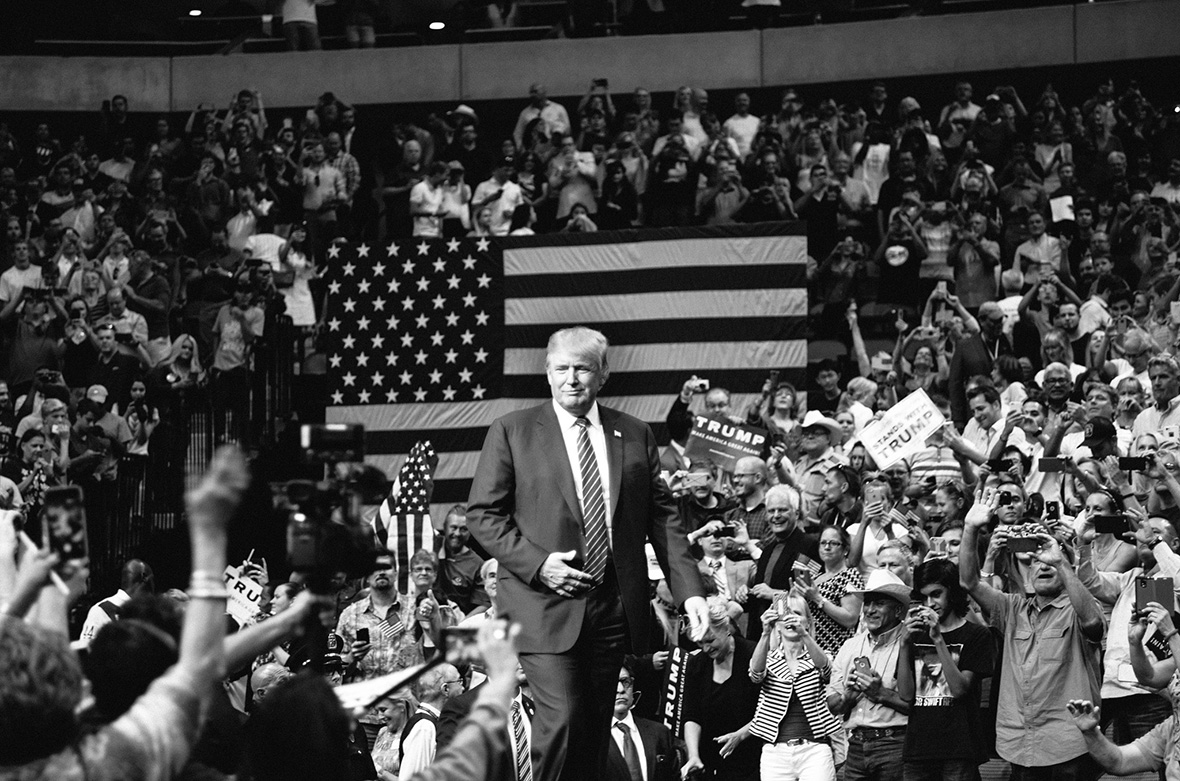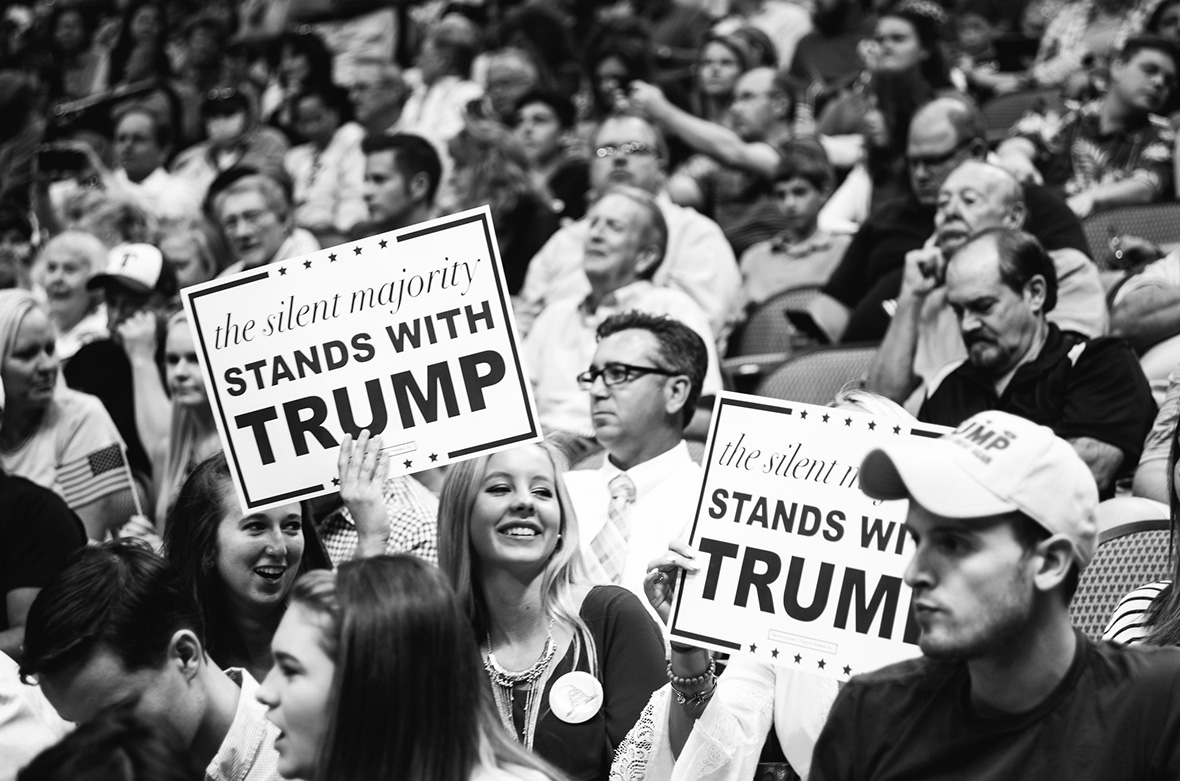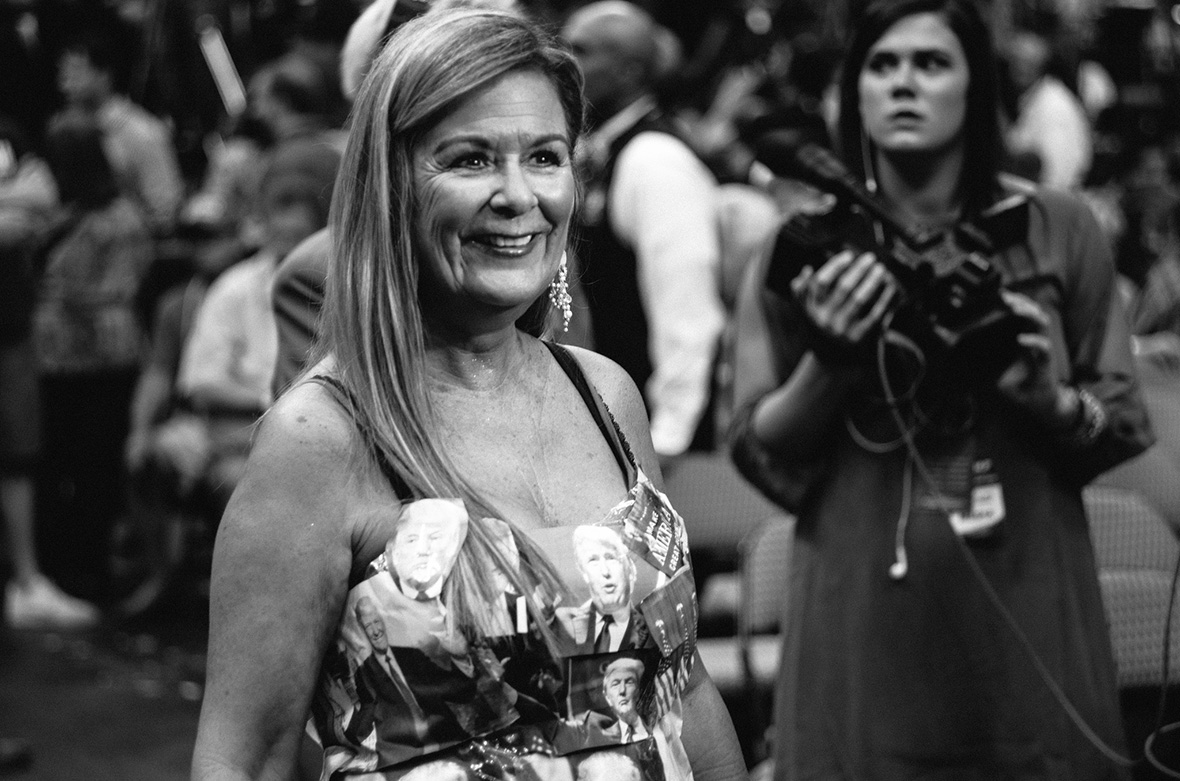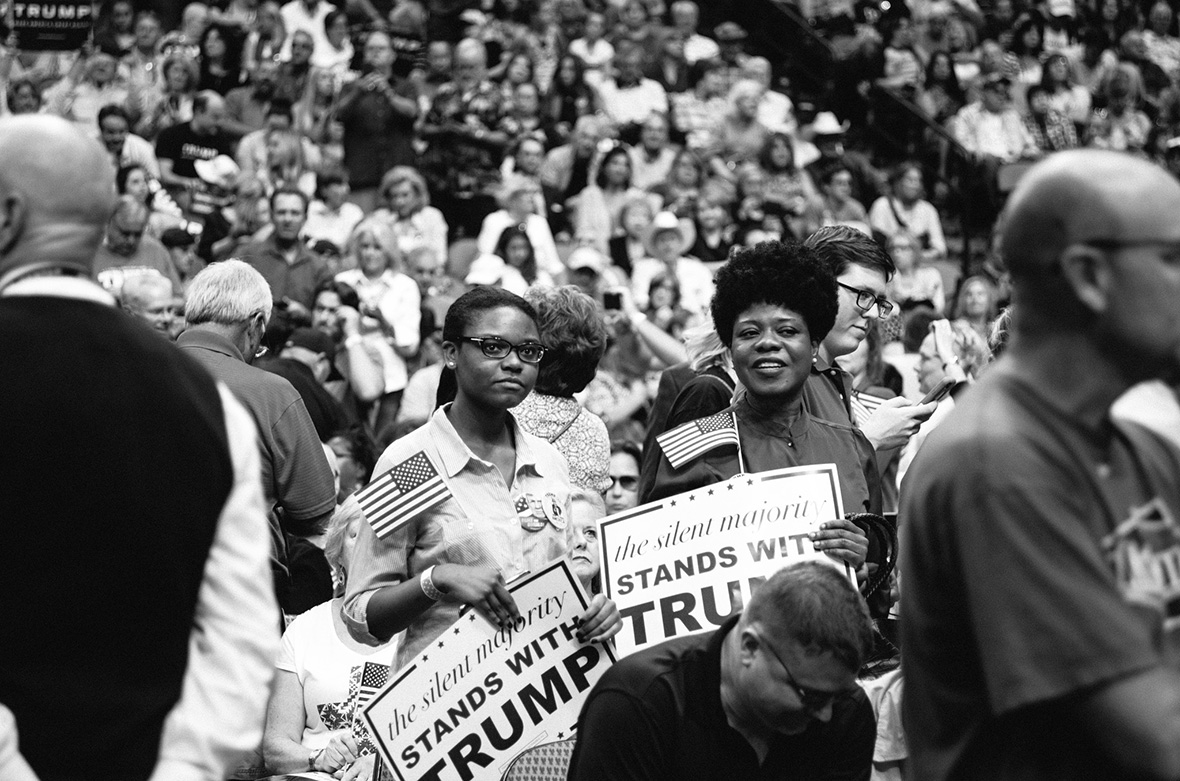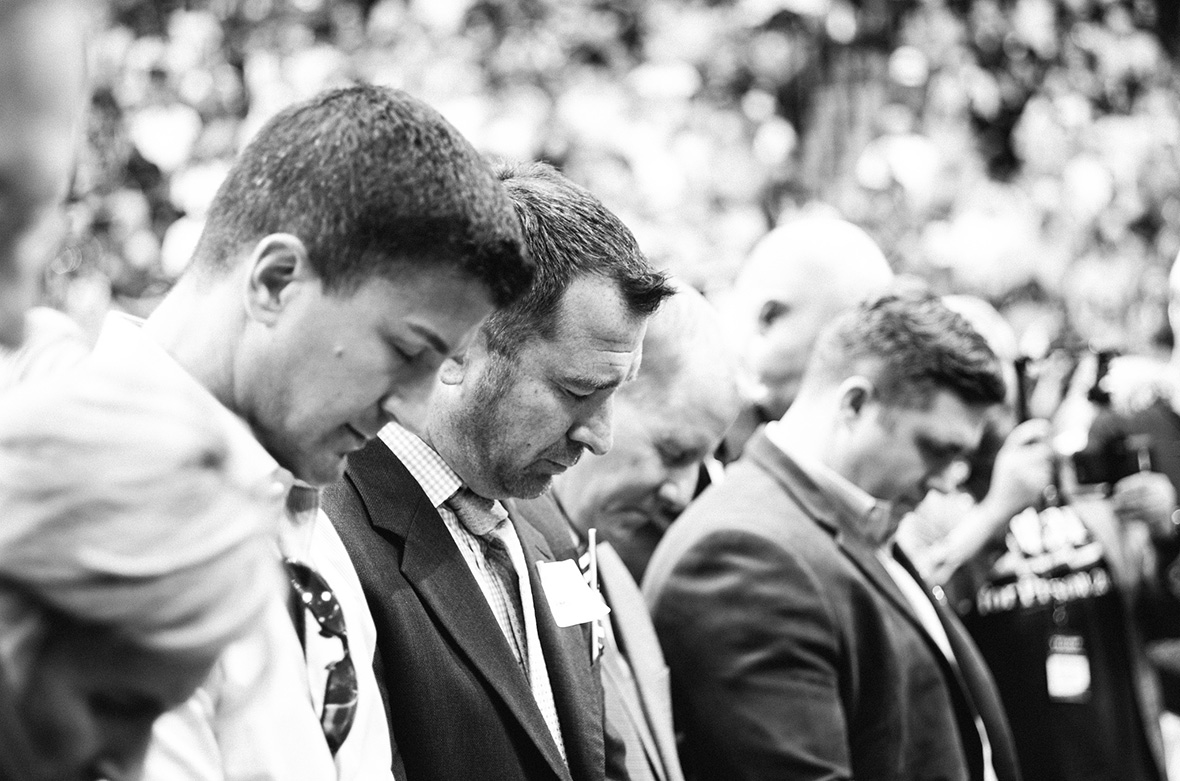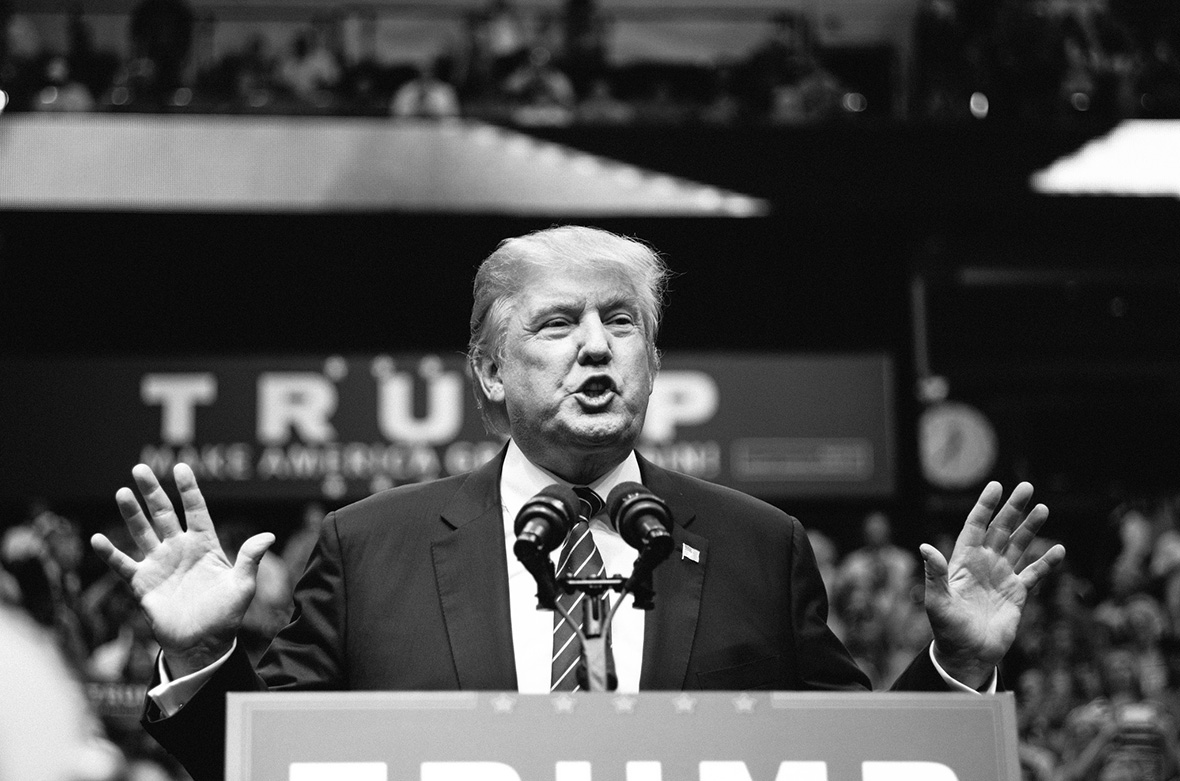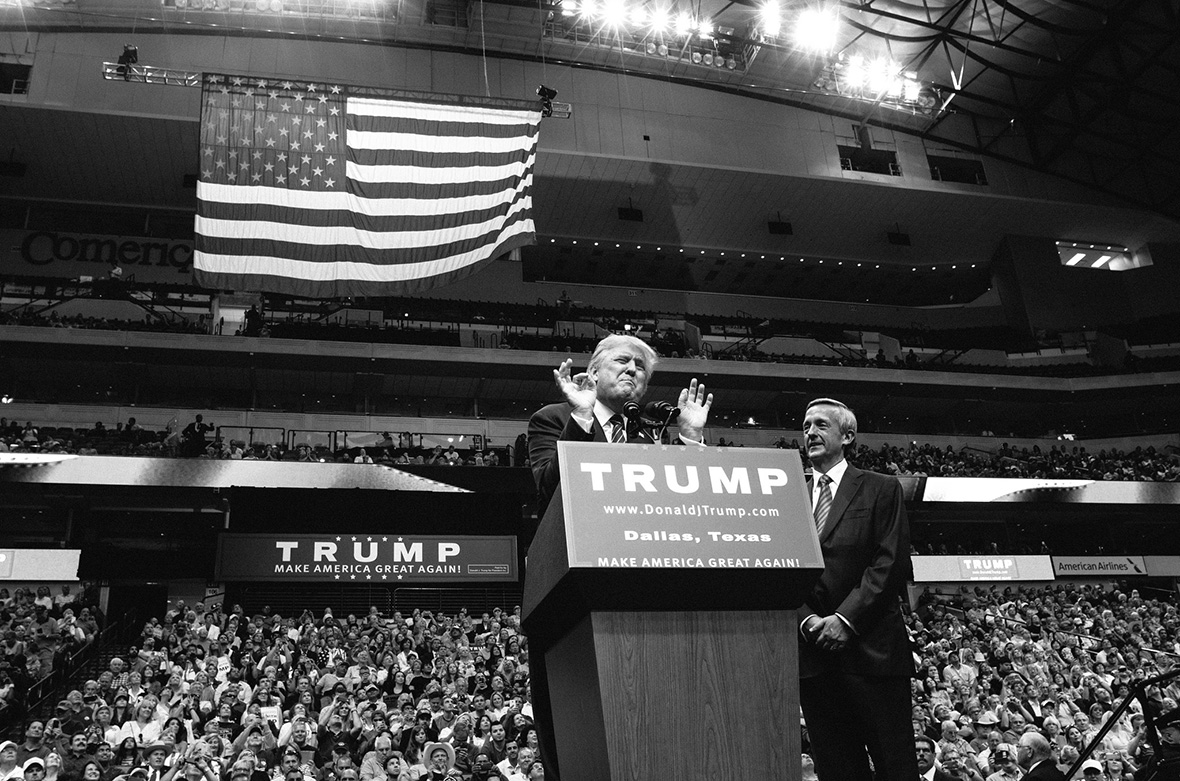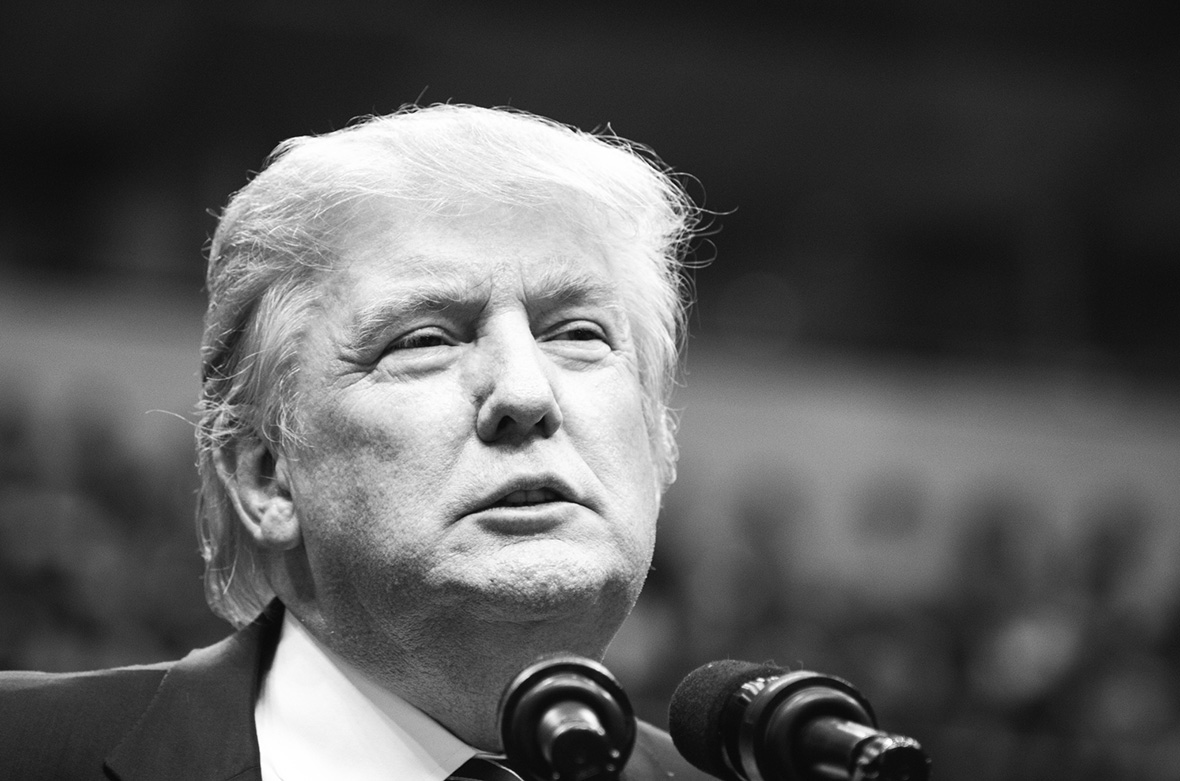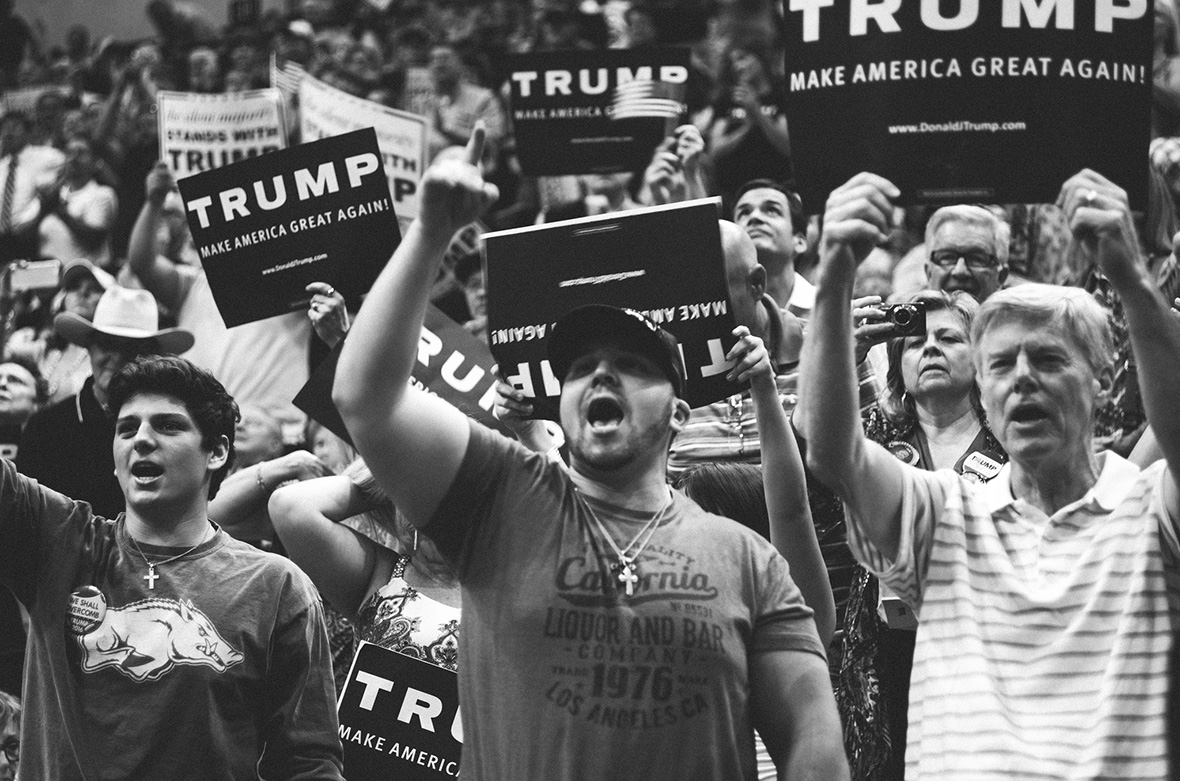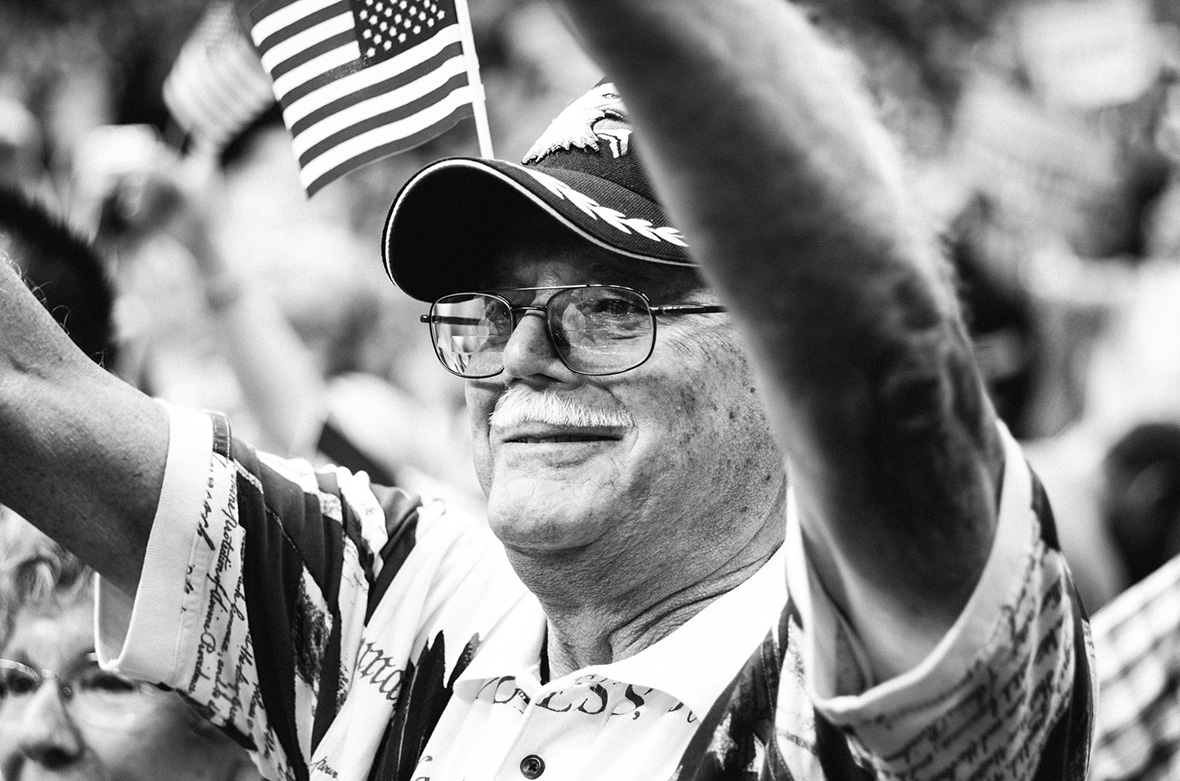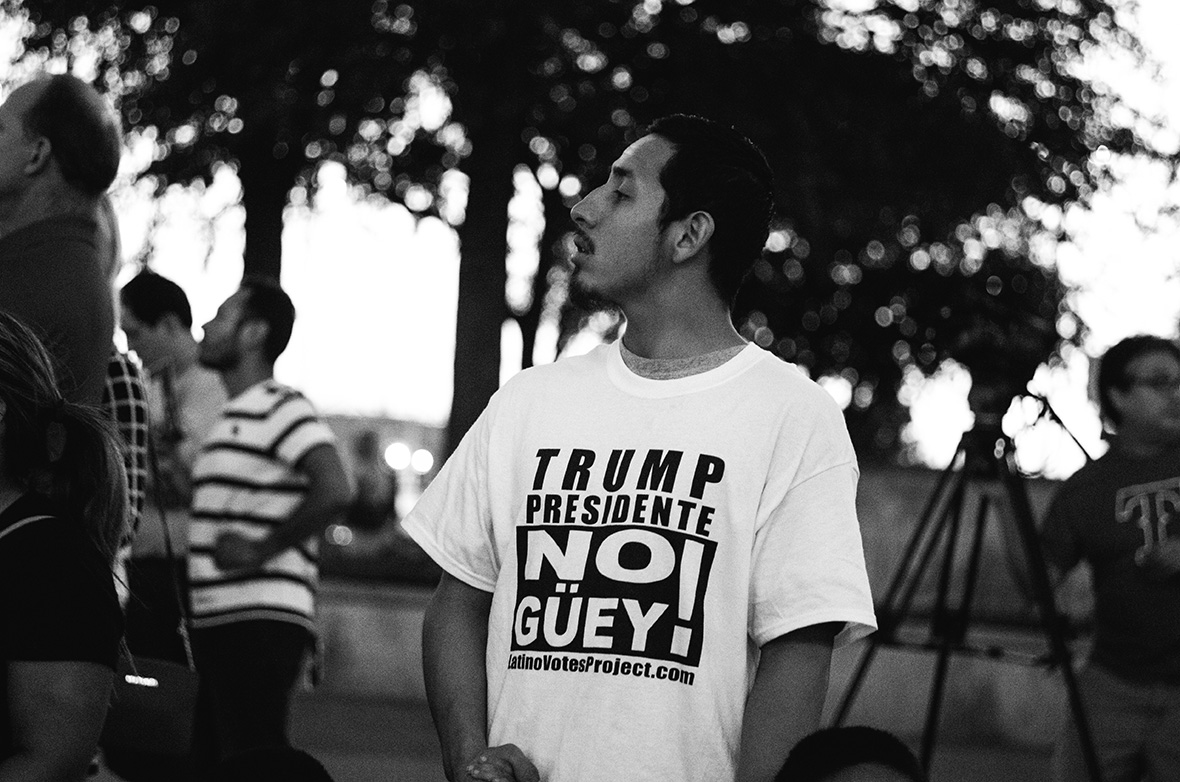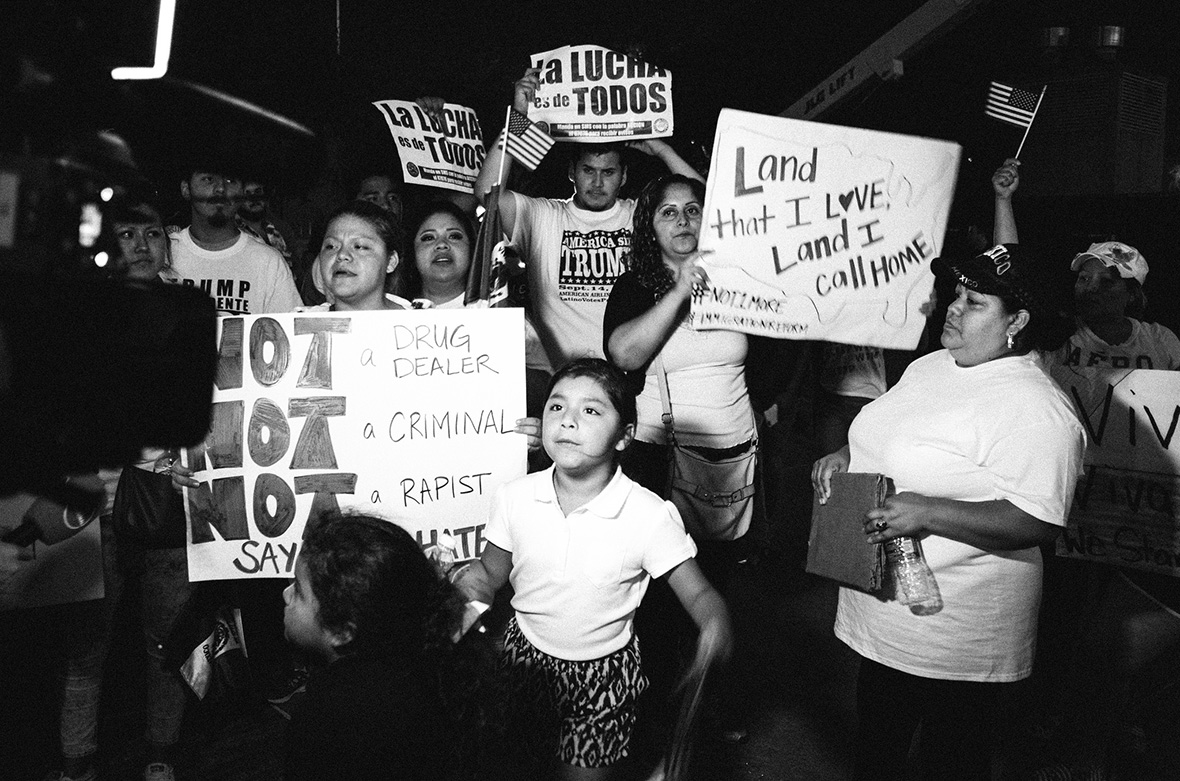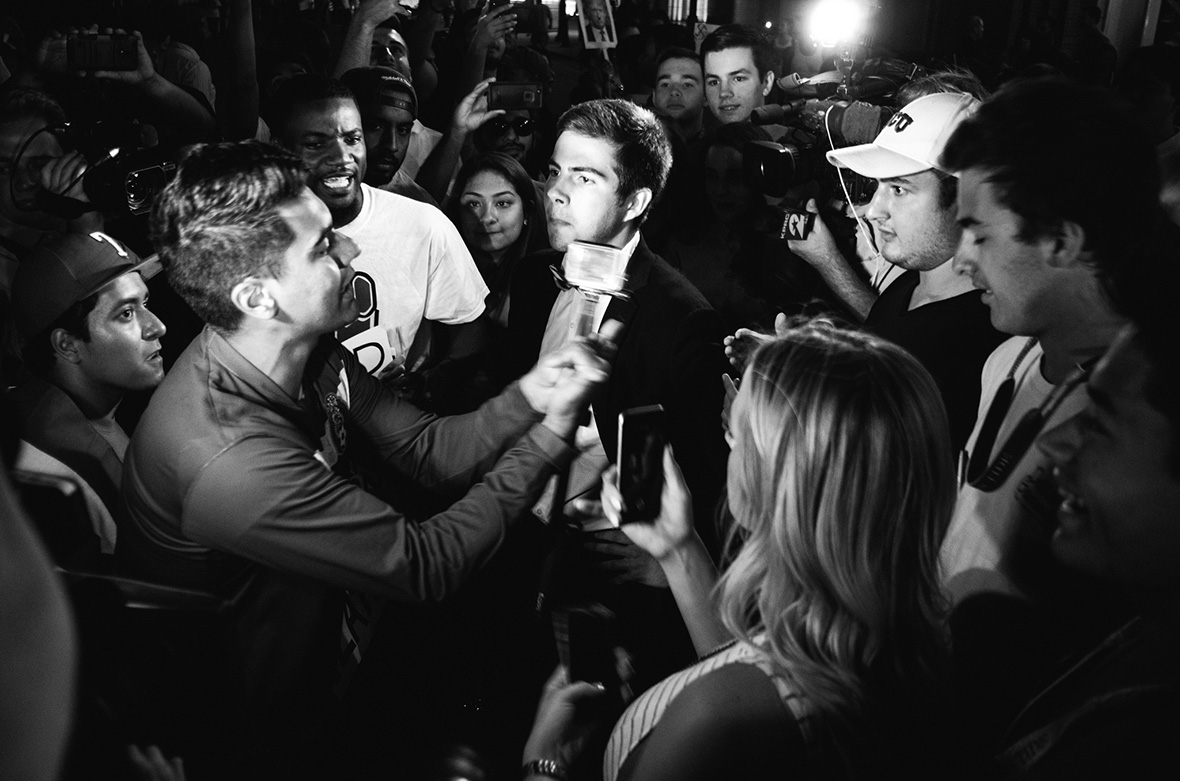Our George Wallace
Donald Trump is a scaremonger. And he’s bringing the most hateful strains of American politics back to life.
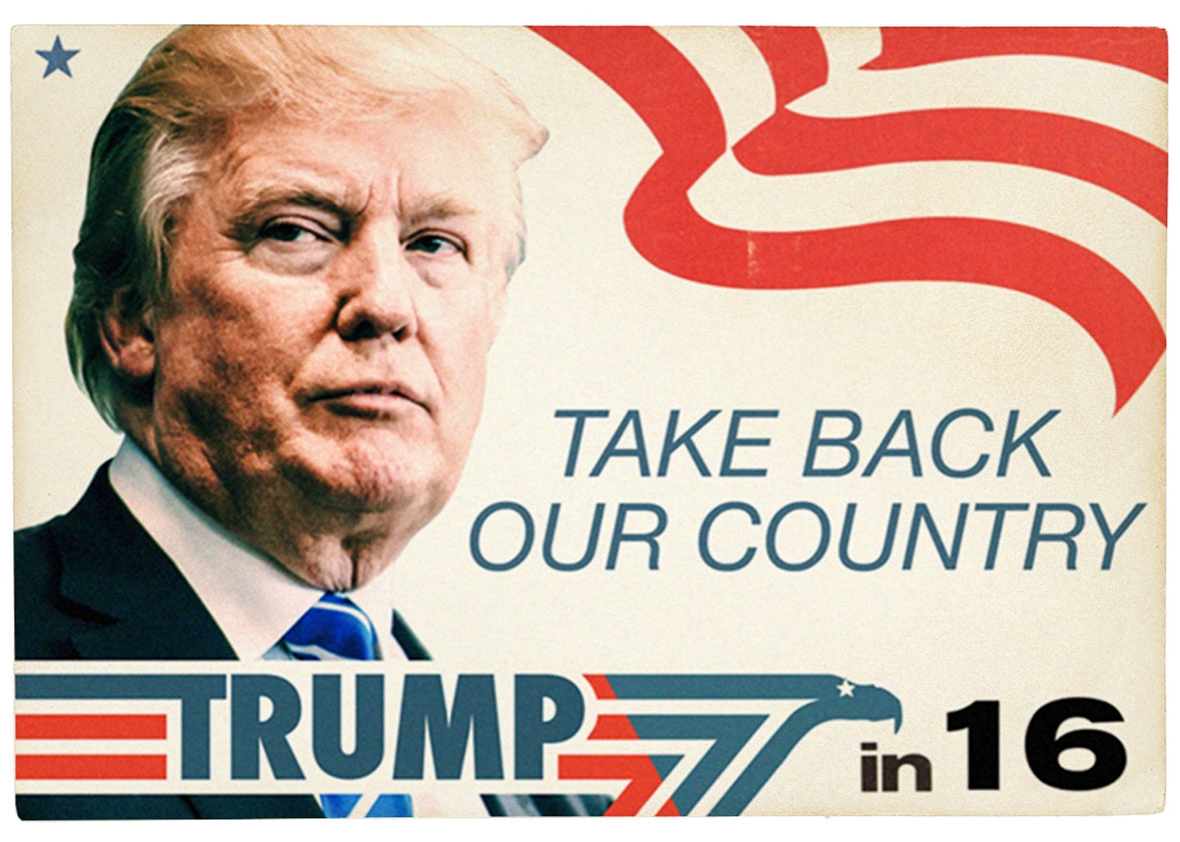
Photo illustration by Lisa Larson-Walker, based on a George Wallace campaign poster. Photo by Sean Rayford/Getty Images.
In Dallas, Donald Trump was a rock star. When he slammed “illegals,” his audience of 16,000 whooped. When he promised to build a wall on the Mexican border, they hollered. And when he closed his event—“You’re going to say to your children, and you’re going to say to anybody else, that we were part of a movement to take back our country, and we will make America great again”—they cheered.
As if to punctuate the meaning of “take back our country,” the post-rally devolved into a confrontation between Trump supporters and Latino activists, protesting the billionaire and his anti-immigrant rhetoric outside the arena. The assembled Latinos were angry. The mostly white rally-goers were vitriolic. “Illegals go home!” yelled one woman. “Deport illegals!” yelled another.
There’s no shock in Trump’s words or their effect. Set aside his talk of doing “deals” and his attacks on rich donors, and the overriding issue in Trump’s message is immigration. For Trump and his followers, immigrants siphon resources, damage the economy, and bring crime and violence. “The cost of building a permanent border wall pales mightily in comparison to what American taxpayers spend every single year on dealing with the fallout of illegal immigration on their communities, schools, and unemployment offices,” Trump says on his website. In his rhetoric, he’s more pointed. “They have to go,” he says. And Republicans agree with him: Seventy percent believe Trump is right when he blames unauthorized immigrants for “bringing drugs” and “bringing crime” to the United States.
Negative attitudes about immigrants exist throughout American society. According to a 2012 survey, for example, 48 percent of young black Americans believe that “illegal immigration” hurts U.S. jobs. But Trump’s rhetoric is more exclusive. It’s a message for white Americans, and specifically, those alienated by mainstream political life. These are ordinary people—blue-collar workers, middle-class professionals, retirees—who feel that their America is slipping away and being replaced by something unrecognizable. They don’t just distrust government—they think it gives benefits to people who won’t work instead of those who deserve help. “I’m just tired of footing the bill for people who don’t want to put in,” said Chris Cooper, one of Trump’s supporters in Dallas. They live in a fast-changing America, and they don’t know how they fit in.
Trump doesn’t just excite and entertain, he speaks to people’s fears and anxieties. With his say-anything style and confident, aggressive persona, he builds a bond with people who want something steady in public, and someone who cares about them above all. “I love that he’s talking in everybody else’s language. He’s not trying to be politically correct—he’s just speaking to us like how we’re talking here, or how you talk to your friends,” explained George Lanier, another supporter at Trump’s Dallas event. It’s why his gaffes don’t hurt him, and why some of his supporters are comfortable enough to voice their prejudice. “We have a problem in this country. It’s called Muslims,” said an unidentified man at a Trump town hall in Rochester, New Hampshire. “You know our current president is one. You know he’s not even an American.”
Trump isn’t just a symbol of voter frustration or outrage with an unresponsive system—the conservative counterpart to Sen. Bernie Sanders. No, from his attacks on President Obama’s citizenship in 2011 to his rhetoric against Latino immigrants and Muslim Americans today, Trump is an avatar of the ugliest impulses in American political life. And while it’s tempting to treat this as simple ignorance, the truth is that Trump comes out of a long tradition of American illiberalism, from the 19th-century “Know-Nothings” who raged against the influx of Irish and Catholic immigrants, to the Reconstruction-era vigilantes and “redeemers” who terrorized black and white voters and overturned elected governments in the postwar South.
These authoritarian currents are always strongest at times of disadvantage, tremendous social change, or both. The America of the 1920s, marked by incredible inequality and a new influx of truly “foreign” immigrants, produced a proto-fascist mass movement of alienated whites, in the form of a new Ku Klux Klan, which claimed 2 million members (including a U.S. senator) at its height in 1924. Trump isn’t a herald for a new nativist fraternity, but his xenophobia, racism, nationalism, and clear disdain for democratic cooperation mark him as a fascistic figure.
But even more than that, he is a classic American scaremonger tapping into recurrent white American anxieties. And while Trump has borrowed his “silent majority” rhetoric from Richard Nixon, the man he most resembles is that era’s id, a demagogue who fed on the fear and anxiety of the 1960s and ’70s—George Wallace.
Wallace wasn’t a businessman or a billionaire. He wasn’t born rich, and he lacked any ties to the American elite. His early life was defined by his remove from wealth and power. His rise in Alabama politics had less to do with privilege and everything to do with drive, talent, and hard work. He ingratiated himself into the high echelons of state politics and eventually—through skillful opportunism—maneuvered to the governorship, where he would halt the “march of centralized government that is going to destroy the rights and freedom and liberty of the people of this country.”
Trump doesn’t reflect Wallace in his biography. The similarity is in his style and approach. Wallace was a politician for people who felt powerless, regardless of the reality. First as a fighter for segregation in the face of civil rights victories and later as a voice for “law and order” against the specter of crime and disorder, Wallace harnessed the fear and anger of millions of Americans with a pledge, in a sense, to take back their country. “I want to say that one of the first things we’re going to do when we get into the White House, and we’re going to do it within the law, we’re going to turn back to you these domestic institutions,” said Wallace in a 1968 speech for his presidential campaign. In the same way, he captured their resentment. “It’s a sad day in the country when you can’t talk about law and order unless they want to call you a racist,” said Wallace in another campaign speech, capturing the anger of the “great majority,” as he described it.
Likewise, in Trump’s rhetoric against immigrants and foreign aid—“They are ripping us. We are rebuilding China. We’re rebuilding many countries.”—we hear echoes of Wallace. “The leadership of the Democratic Party and the Republican Party have paid more attention to the exotic and those who made the most noise, they have given [the average citizen’s] money away in foreign aid, they have given it away to welfare loafers,” Wallace said on a 1972 episode of Meet the Press.
Wallace’s supporters didn’t constitute a social movement. “Although they are an important bloc of voters, in the end they were only a loose collectivity attracted to Wallace and to the sentiments he expressed, more like a fan club than anything else,” writes sociologist Jody Carlson in George C. Wallace and the Politics of Powerlessness. Wallace, she continues, “was a one-man phenomenon.” The topics are different (integration versus immigration), but the parallels with Trump are clear. Like Wallace, Trump isn’t ideological. His views—he’s for taxes on the wealthy and against entitlement cuts—run counter to conservative dogma.
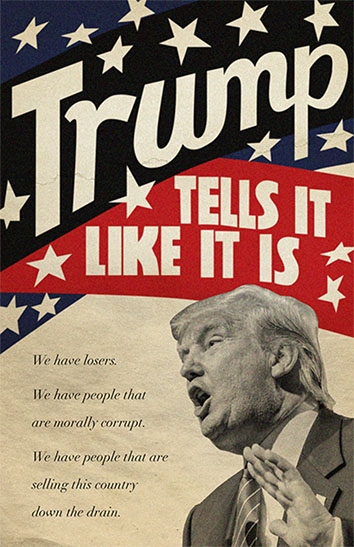
Photo illustration by Lisa Larson-Walker, based on the cover to a collection of George Wallace's transcripts. Photo by Nancy Wiechec/Reuters.
His supporters aren’t ideological either. Their concerns are more concrete. Trump speaks to them—“A lot of people up there can’t get jobs. They can’t get jobs, because there are no jobs”—and gives them a clear scapegoat: “Because China has our jobs and Mexico has our jobs.” They are here for him and no one else. Or, as one steelworker said of Wallace in 1968, “You don’t have to worry about figuring out where he stands. He tells it like it really is.”
“Wallace’s supporters are distinguished from others by their authoritarianism, feelings of political powerlessness, and racial prejudice,” writes Carlson. Those words serve as an apt description of the Trump phenomenon as well. Wallace’s protest politics “were essentially expressive … not designed to move in any productive way toward getting more power for the people, but to make them feel more powerless instead.” Indeed, continues Carlson, Wallace thrived on “turmoil, excitement, [and] discord. He is interested in exploiting issues, not solving problems.”
Like Trump, Wallace appealed to his followers in a base, almost visceral way. “He was … the perfect mimetic orator, probing his audiences’ deepest fears and passions and articulating those emotions in a language and style they could understand,” writes historian Dan T. Carter in his book The Politics of Rage: George Wallace, the Origins of the New Conservatism, and the Transformation of American Politics. “On paper his speeches were stunningly disconnected, at times incoherent, and always repetitious. But Wallace’s followers reveled in the performance; they never tired of hearing the same lines again and again.” In the same fashion, Trump’s followers don’t need novelty. “He was tremendous—the same everywhere he goes,” said one supporter at his Dallas rally.
Wallace never won a national election. His slice of alienated America wasn’t large enough to prevail in a broad contest. But he wasn’t marginal. In the 1968 presidential election, running as an independent, Wallace pulled 13.5 percent of the vote, carried five states—all in the South—and won 46 electoral votes. And in the 1972 Democratic primary—where he, like Trump this year, was an explicit “outsider”—he won 23.5 percent of the vote (or more than 3.7 million ballots) and collected 382 delegates, placing him third in the overall field.
Beyond his campaigns, Wallace shaped the contours of American politics. He was a master of television, the ascendant media of the era. “[O]n the flickering television screen and in dozens of personal appearances he offered to those frightened and insecure millions a chance to strike back—if only rhetorically—at the enemy,” writes Carter, in a sentence that could easily describe Trump’s relationship to social media.
More importantly, Wallace helped generate the forces that Richard Nixon would use to build a national Republican coalition in the wake of national discord and a fractured Democratic Party. Nixon didn’t indulge the explicit racism of Wallace and his supporters, but he co-opted the clearly racial focus on crime and criminality, tying civil rights to urban disorder. "[T]he deterioration [in respect for law and order] can be traced directly to the spread of the corrosive doctrine that every citizen possesses an inherent right to decide for himself which laws to obey and when to disobey them,” he said in a 1966 interview.
In his 1968 campaign, Nixon took a subtle stance against federal desegregation plans—calling for ineffective “freedom of choice” policies—and walked a delicate balancing act of appealing to white fears without sounding extreme. Aware of the Wallace threat to his presidential effort, Nixon worked those voters to his side. “Don’t play their game. Don’t divide your vote,” said Nixon in an ad aired before the election. “Vote for … the only team that can provide the new leadership that America needs, the Nixon-Agnew team. And I pledge to you we will restore law and order in this country.” Nixon took the Wallace stew of powerlessness and resentment, and brought it fully into the mainstream, shorn of its open racism.
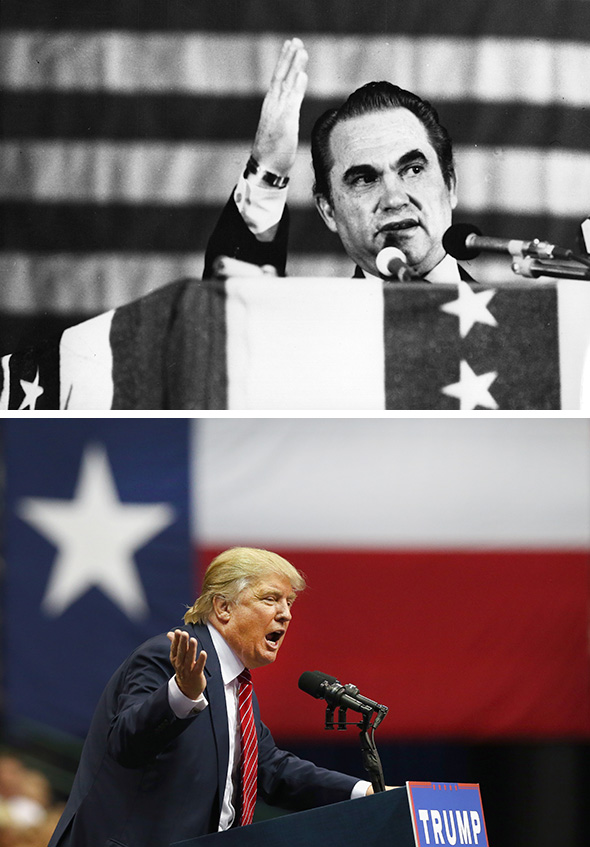
Photo by Alan Band/Keystone/Getty Images, Photo by Tom Pennington/Getty Images
Which brings us back to Donald Trump. Everyone’s assumption, including my own, is that Trump will fade before voting begins. It’s a strong case. Trump’s popularity rests on his novelty as much as anything. He plays to the cameras, aware that politics loves a sideshow. But if the media goes away—if Trump can no longer titillate—then his appeal goes too, and he’ll leave the presidential race like every other vanity candidate.
The Wallace analogy, however, suggests a different path. What if Trump is more than just a clown? What if he’s unleashed a real constituency for nativist, authoritarian politics? Then it’s not hard to imagine how Trump, riding on his own wealth, keeps the show going into Iowa, New Hampshire, and beyond. And while our political system is fractured enough to deny him an ultimate victory, that doesn’t mean this wouldn’t matter. For the GOP—much like the Democratic Party in the 1960s—a successful Trump would force a reckoning. Either Republicans cut him out of the party, even at the risk of losing in a three-way race, or they follow Nixon’s example and co-opt his basic message for the party’s use, shrinking his base enough to win if he runs an independent campaign.
In which case, by leaving the mark of white nationalism on the Republican Party, Trump wins regardless of his ultimate fate.
Either way, we can’t just dismiss Trump as entertainment. Like Wallace, he is an eruption of the ugliest forces in American life, at turns authoritarian, like the Louisiana populist Huey Long, or outright fascistic, like the Second Ku Klux Klan. And like all of the above, he’s brought the background prejudice of American life to the forefront of our politics, and opened the door to even worse rhetoric and action.
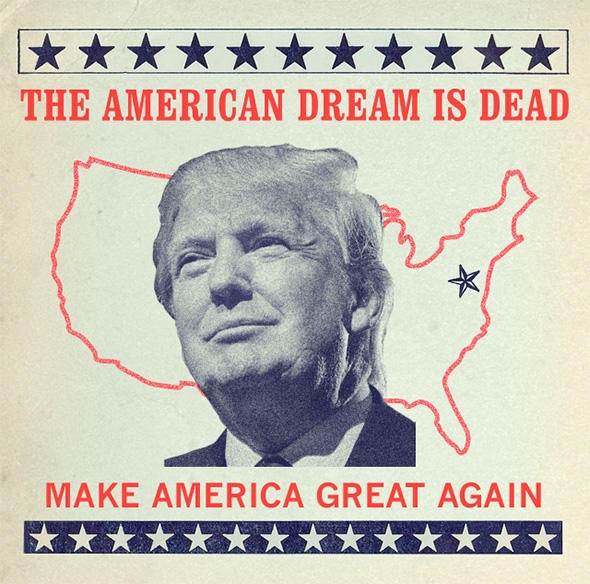
Photo illustration by Lisa Larson-Walker, based on a George Wallace campaign poster. Photo by Nancy Wiechec/Reuters.
The only good news about Trump is that he has awful timing. The United States has large and important problems, but it’s also not mired in crisis. “U.S. businesses have added 13 million jobs over 66 straight months of employment growth, with the jobless rate dropping 10 percent to 5 percent,” notes Politico. “The budget deficit has fallen from nearly 10 percent of GDP to less than 3 percent under Obama, while the uninsured rate has fallen from 15.4 percent to 9.2 percent under Obamacare.” Crime is still on its downward trend, American troops aren’t committed to major wars, and the administration isn’t embroiled in scandal, at least not on the scale of impeachment, Iran-Contra, or Watergate. A vocal minority feels powerless and disaffected, but most Americans—if their actions mean anything—don’t. They want a different direction, not a different system.
But that’s the luck of the draw. What if this were 2008, on the heels of a disastrous war and on the verge of a depression? What if the stimulus never happened and—like many other countries across the Atlantic—we met recession with austerity? What if the fear and discontent of those years curdled into anger and unrest?
In that environment, a Trump or Trump-like figure—someone more organized, more competent, and more attuned to the structure of American politics—could succeed, despite our jokes and ridicule. Americans like to believe that, unlike Europe, we can avoid demagogues and authoritarians in our national politics. For the most part, it’s been true. But make no mistake: With the right conditions, it can happen here.
